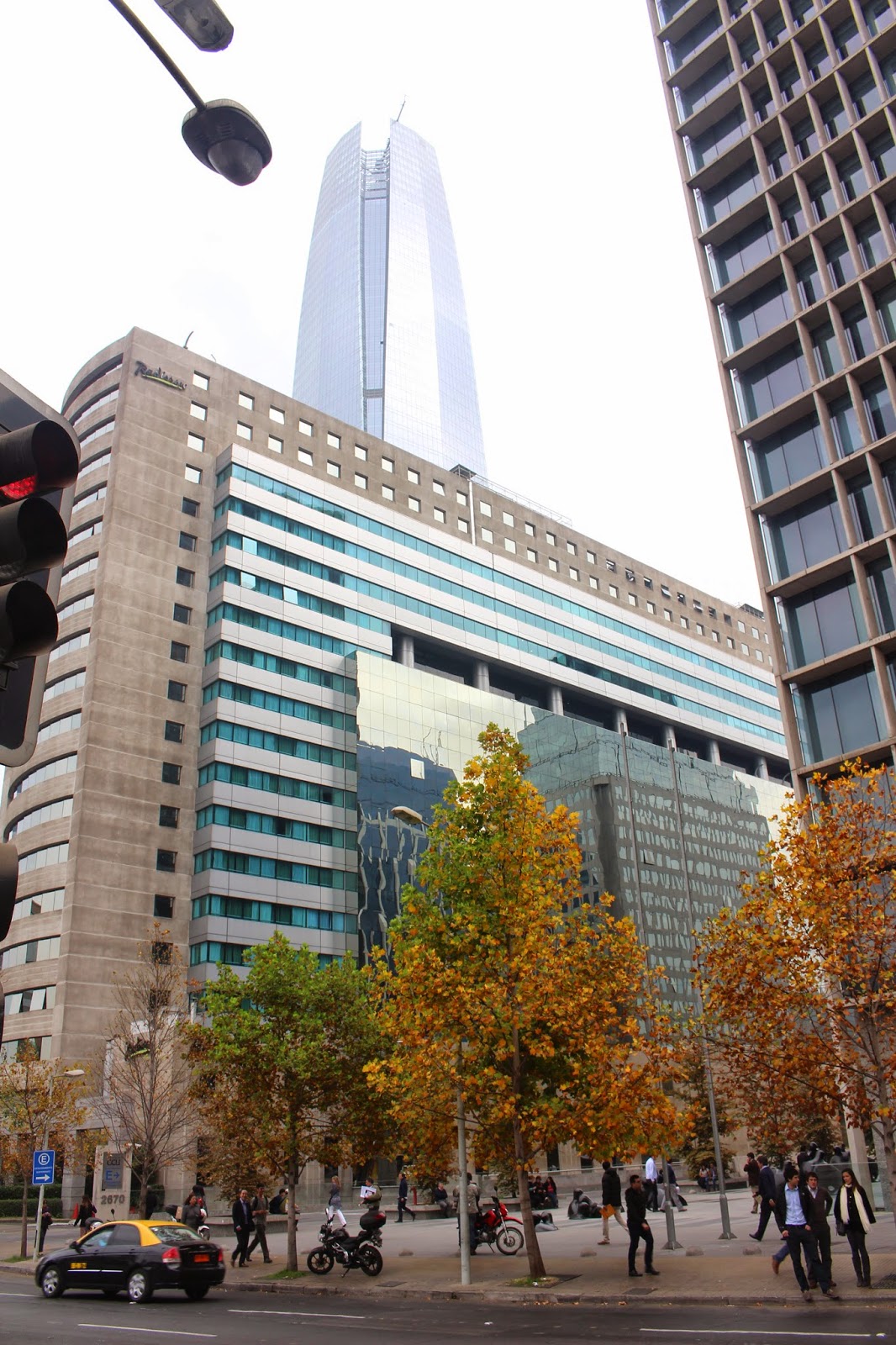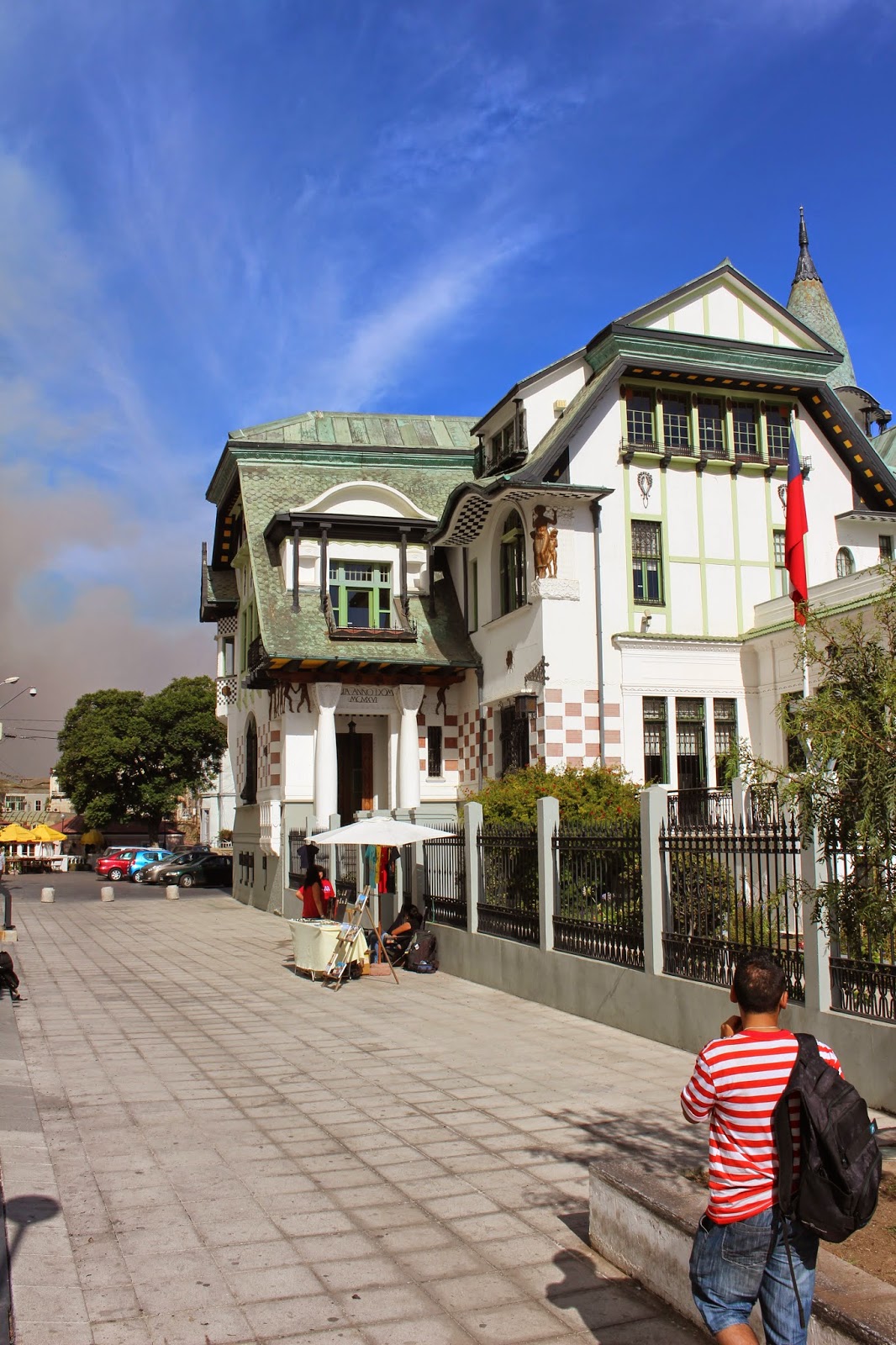On April 12th, we flew into Santiago from Antofagasta, jumped on a bus to the main bus terminal in northern Santiago, paid $3.500 CLP for a second bus ticket (per person), and embarked on a 2-hour trip to Valparaiso. The ride was unlike any I had been on before in the country and filled with beautiful landscapes. The first thing worth noting is that for $3.500 CLP you get a semi-cama seat and can relax to your heart's content. The second thing worth noting is that you will not have the opportunity to recline your semi-cama seat because you will be glued to the window as the bus passes through one of the richest vineyards in the country. If you were unfortunate enough to get an aisle seat, do yourself a favor and buy your return ticket in advance. After flagging down a taxi, we proceeded to rendezvous with my parents at a local bed and breakfast.
To save you time I would like to say that B&B La Casa de Henao is in no way recommended aside from a mediocre view from their third‐story suite. If you are curious as to why I say this or are currently considering booking accommodations in Valparaiso, read on:
Despite calling in advance to confirm the reservation, B&B La Casa de Henao managed to "mix things up" and left us in a bedroom with a shared bathroom. Normally I would be fine with this (it has happened enough times during our stay in Chile to deem the frequency statistically significant) as long as a discount is provided (we were paying $100/night after all) or some concession is made, but neither was offered. After being promised an "extra special breakfast" we finally accepted. Now would probably be a good time to say that the aforementioned breakfast was either forgotten altogether (by the staff), it was so minute that we failed to notice it, or everyone at the B&B got the "extra special breakfast" every day that we were there. Normally I would not hijack my own blog to speak poorly of accommodations but this place was really "extra special." The owner and operator offered to give my father a good deal on driving us around to vineyards in the countryside the next afternoon. I later found out that the going rate for 4 hours of driving to a single vineyard came in at $300 and that did not even include entry to the vineyard or lunch (which we actually bought for him). If you are going to visit the vineyards, I recommend either renting a car ($45/day) or a private driver ($150/day). The last item to mention, aside from the incessant off-topic unsolicited (and often sexist) ranting of the owner, is that when we asked for them to call a taxi to take us to the bus terminal, they offered to take us there for the same rate. While some hotels and B&Bs will actually offer to take you for free, the owner had the audacity to charge us $12.000 CLP (the going rate, and what we paid to get to the B&B from the bus terminal, is a whopping $6.000 CLP).

After our eventful check-in at the aforementioned-less-than-desirable-definitely-not-worth-the-price-overrated lodging we headed out for lunch. By the time we got to the quaint cafe with a nice rooftop patio, the smoke that we had seen slowly beginning to rise as we walked to the cafe had grown into billowing clouds.
And by the time sunset came around, we found our puesta del sol accentuated by the expanding cloud of smoke. It was about this time that another group of foreigners behind us spoke up. "Does this seem strange to y'all? I'm a back woods firefighter from Tennessee and we should have heard sirens by now," he stated. After being startled by the first English we had heard in a while aside from my parents, we had to agree.
We asked for the cuenta, a nice surprise as it was cheaper than Antofagasta, added the standard 10% tip, and headed back to the B&B. On the way home we started noticing little pieces of ash falling and both my father and I did our best to capture the looming aura that hung over the city. Above you can see one of the beautifully maintained antique houses that led to the city's World Heritage Site status (determined by UNESCO in 2003).
As we walked home, dusk rapidly spread throughout the city, and we began to doubt the city's ability to contain the fire. The first flames became visible as the fire crept over the cerro closest to our location.
Within a block of our place, we turned to see the fire continuing to advance and darkness engulfing the city. As the winds picked up, our concerns quickly grew.
A quick shot from the previously mentioned suite. While the city at night appeared to be a beautiful sight, the extent of the blaze started to become visible.
Despite reassurances from our concierge, you can see why some members of our group were hesitant to go to sleep that night.
As dawn broke and the news reports were optimistic, a quiet calm spread throughout the city.
The lingering smoke from the night before proved to be a fun tool for learning the limits of the new camera my parents brought me for a combined Christmas/birthday present.
I can assure you that this was neither the first nor the last time that my father tried to show me how the camera worked.
One of the perro vagos being too cute to deny. Often seen as a problem throughout Chile, their presence is very controversial. Though I do not want to explain the controversy in its entirety here, I will note that Valparaiso had a clever system for containing the problem: they are taken in, spayed or neutered, and given a red ribbon on their collars to inform people that the have been "operado".
After being founded in 1536, Valparaiso has been and continues to be one of the largest shipping ports in Chile.
You can see two cranes taking a break from their constant loading and unloading.
It was in Valparaiso that a tour guide informed us that building developers in Chile often made deals with local artists. According to the guide, there exists an agreement between taggers and artists; they will not paint on top of each other's work. By having an artist paint a mural on the side of their buildings, developers ensure that the building will not be covered in patchwork graffiti.
Another view of the port
A short ride up one of the city's funiculars provided us with easy access to some of the most stunning views of the city.
I found Wally! Somehow Waldo lost his name in translation.
It quickly became visible during the three-hour
Tour4Tips walking tour (highly recommended) just how the UNESCO group determined that Valparaiso was a World Heritage Site.
Halfway through the tour we came across these neat spice planters. Utilizing locally sourced fruit cartons (from a dumpster) and large 50 gallon plastic bags, their designer was able to create a nice spice garden with both minimal cost and footprint.
More street art. The air smelled like a strange mix of fresh paint and smoke.
By the time we got to the highest point in the city, a second fire had broken out. Sadly, between the damage of the first fire and the smoke of the second fire, evacuations and Carabineros kept us from finishing our tour.
When we got back to our place, a light chirping brought us to the window.
In the fig tree next door we spotted a few parrots munching on some ripe fruit.
The one vineyard that was included in the pricey tour: Casas del Bosque. The tour, though brief, took us through the processing and aging facilities of the vineyard.
After the 15‐minute tour, we moved on to the tasting room. Thanks to my parents we were the only ones who had the opportunity to taste the delicious Private Reserve. Whether it was the fancy aerator she used or just the wine, we left the tasting room feeling pretty good.
The acres and acres of vineyards that the tour didn't even touch. With the confidence that the wine instilled in us, we proceeded to give ourselves a private tour of the rows of vineyards. Sometime later a staff member informed us that we were in a restricted area and escorted us from the premise.
At the end of road F-800 you will come across a small fishing town with no name (at least not according to Google maps). Located just to the south of Valparaiso, this fishing town was a great place to eat lunch and dilute the wine in our systems. You can see how happy my mom is to be back on land after a two week cruise through the Magellan Straits.


















































